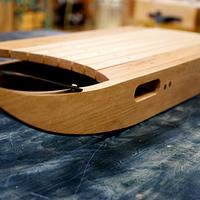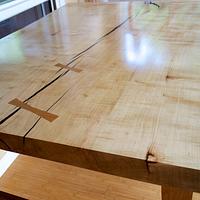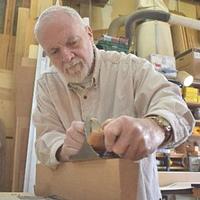
MsDebbieP
in over 11 years
WoodworkingWeb Interview: Manitario
This interview with Manitario is from May, 2016.

1. What is your “inspiration story” — where did your interest in woodworking all begin?
I’m not really sure where my interest in woodworking began. I had a grandfather and an uncle who did woodworking as a hobby and a father who did carpentry as a hobby so I guess it was kind of inevitable that I’d be a woodworker. I didn’t really have much interest growing up in woodworking (took automotive shop class instead of woodworking!) but I did end up with a basic familiarity with tools.
What really kick started my woodworking was a basement reno project; I gutted and refinished my basement and at the end I suddenly had a bunch of tools that I had no obvious use for…suddenly a few really simple woodworking projects seemed possible, eg. my very first project was a simple plywood bench, then a set of plywood shelves….every project seemed to need a new tool and a new skill set…it’s was a slippery slope from there to now.
Every new project is a new inspiration and a new challenge; I think that if I had stopped at the beginning and stuck with building screwed together shelves, I’d have lost interest. Woodworking is a constant new challenge to create something beautiful.
2. Who is your woodworking mentor and why?
I don’t really have a specific mentor. Learning woodworking was the result of reading a lot of magazines and a lot of looking online at what others were doing on the various woodworking forums. Books and articles by Robert Wearing, Garret Hack, Christopher Schwartz, Paul Sellers and Ron Hock were really foundational for me for learning how to sharpen and use basic hand tools. I have a large collection of books on various woodworking machinery use, eg. bandsaw/tablesaw etc. that was really important to me initially to learn the basics, eg. don’t touch the sharp bits.
We really are living in a fantastic era for woodworking resources; there is so much being published and blogged and youtubed that it is very easy to find inspiration and teaching.
3. Power or hand tools? … and why
I use a mix of power and hand tools. Mostly power tools to size/shape/dimension wood and usually to do the roughing of the joinery. Handtools are great for the final shaping/fitting etc. I frequently find myself devising some sort of complicated and unsafe way to use power tools and then I stop and realize that I could use a hand tool to do the same job in a quicker, safer way.
4. What is your dream project and when do you think you will tackle the challenge?
Good question! My original dream project was to make a big slab dining room table. I finished that a couple of years ago. Now I don’t have any particular dream project on the back burner, but I imagine like most of us, I have a long list of projects in my head waiting for time to do them. I’m just finishing up a cabinet and then I think my next project will be a couple of staked chairs a la Chris Schwartz (Just finished reading “The Anarchist’s Design Book”).
5. What is the greatest gift that this craft gives you?
I have a high stress job in an emergency department. I often come home with my mind spinning and tense with stress; woodworking is a quiet, methodical hobby that I can take my time with and try and enjoy some of my creativity. I call my workshop the “bullsh*t free zone”; when I’m in there it is just me and my tools, no pressure, no time constraints and no expectations other than my own. Makes for a peaceful way to unwind. There’s a great quote that I keep meaning to put up on the wall of my shop: "Work with your hands. As a result, work on yourself. Spend time alone with your thoughts away from the clamor. See what you can make of the time at the bench. I can think of no better elixir for the cacophony that makes up a day in the world today. -Gary Rogowski”
- 6. What are your “words of wisdom” that you want to pass on to others, especially to beginners?*
Be patient. Woodworking, like any skill is progressive, you will make a lot of mistakes but there is always more wood and always more time. Try to use each project as a way of learning a new technique, a new skill, a new tool. Especially as a beginner; the amount of information is overwhelming; there are 20 different ways and 40 different jigs to cut every joint. I spent a lot of time making jigs and buying stuff that I never use because I thought that I had to. Most of woodworking should be simple, if it takes 10 different steps and 3 different jigs and 5 test joints to cut one joint, there’s probably an easier way. Along with this advice; learning to sharpen and use handtools will be the biggest and most enjoyable timesaver in your shop. I can spend a lot of time finicking with my machines to cut a joint or just cut it close and spend 2 minutes with a good sharp chisel or plane.
JAGO - just a grandma’s opinion
10 Comments
Very good interview,very interesting.
woodworking classes, custom furniture maker
Good advice, good story equals a great interview. Thank you.
Jack
Great word of wisdom.
Abbas, Castro Valley, CA
Very interesting , woodworking is a calming activity . Create what you want when you want. The sign in my shop says " If you can’t afford it , build it " .
Wheaties
Lots of good “sharp” points. Thanks.
Thanks guys!
Bruce; I should have said that most of the time woodworking is a calming activity. There have been moments where bad words have been said and/or wood thrown across the shop…
Rob, Sault Ste. Marie, Ontario
Nice to meet you!
The early bird gets the worm but its the second mouse that gets the cheese.
Thanks!
Rob, Sault Ste. Marie, Ontario
Love the quote and the advice is very useful. Nearly all of my kit is hand tools so I am slowly getting to grips with sharpening
?
I like your word of wisdom.
It’s everything I tell myself.
I, however, never followed the one on being patient with disastrous results :)
Abbas, Castro Valley, CA






















